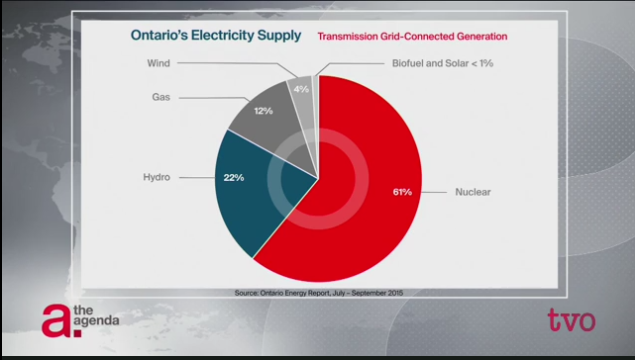Such as:
Wind, solar and bioenergy still account for just 9 per cent of Ontario’s electricity output despite the provincial government’s bungled, vastly expensive effort to promote them.I hope all read Like it or not, Toronto is a nuclear city, but the rest of this column is going to be about media in Toronto's steady production of poorly researched material - just using the 9 % figure.
To start... here's a graphic from a segment of The Agenda with Steve Paikin interviewing newcomer head of Ontario Power Generation Jeffrey Lyash:
I happened to enjoy this interview, but I've been critical of Steve Paikin in the recent past and the graphic shows why. The graphic says, "Source: Ontario Energy Report, July-September 2015" - but that wouldn't be notable on the television during the program. The ontarioenergyreport.ca website does currently show prominently, on its home page, these percentages for 2015's third quarter "Transmission Grid-Connected Generation Output" - which is only a subset of "Ontario's Electricity Supply", and only for the quarter of the year when industrial wind turbines are least productive. If The Agenda's researchers went a step further, to the full supply report linked to following the percentages., they's have found the source table for the full year's data (2015), where wind was 5.8% of the annual "Transmission Grid-Connected Generation Output" subset, and solar and biofuel another 0.5%.
That one step further is how far the Toronto Star's assembled team went in January while assembling Q & A for Ontario’s hydro system.
How is Ontario's Electricity Generated?Including all transmission grid-connected data from 2015, instead of low-wind third quarter data only, brings with up to 6% from 4%, with solar and biofuels still showing as <1%.
The majority of Ontario’s electricity — 60 per cent last year — comes from nuclear reactors at Bruce, Darlington, and Pickering. Almost a quarter — 24 per cent — is from hydro-electricity from places like Niagara Falls, while 10 per cent comes from natural gas-powered generating plants. Only 6 per cent is from wind, and less than 1 per cent comes from solar, with a similar amount of electricity generated by biofuels.
I wrote on the shortcomings of the Star's reporting at the time in ignorance shines on solar - and Toronto. That post contains some citations demonstrating others concerned about the reporting shortcomings of distribution connected, a.k.a. embedded, generators.
To estimate 2015's total generation with the best data publicly available I propose one would take the generation totals for transmission grid-connected resources from the IESO's site, and use the most current reporting of capacity to gross-up those figures to include distribution connected (Dx) generators.
"A thing of beauty is a joy forever"
It's 9%: wind (6.5%) solar (2.2%) and biofuels (0.3%).
Well done Mr. Gee.



No comments:
Post a Comment